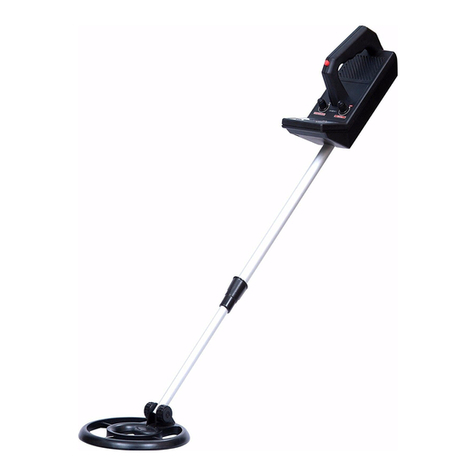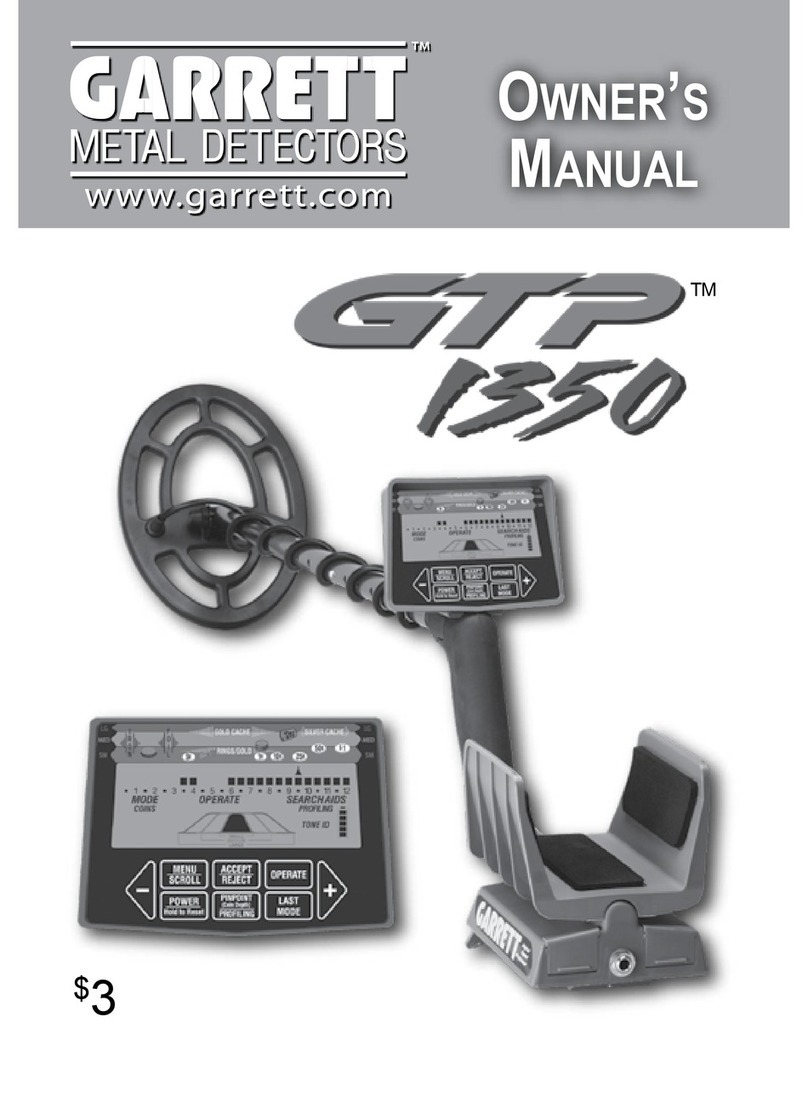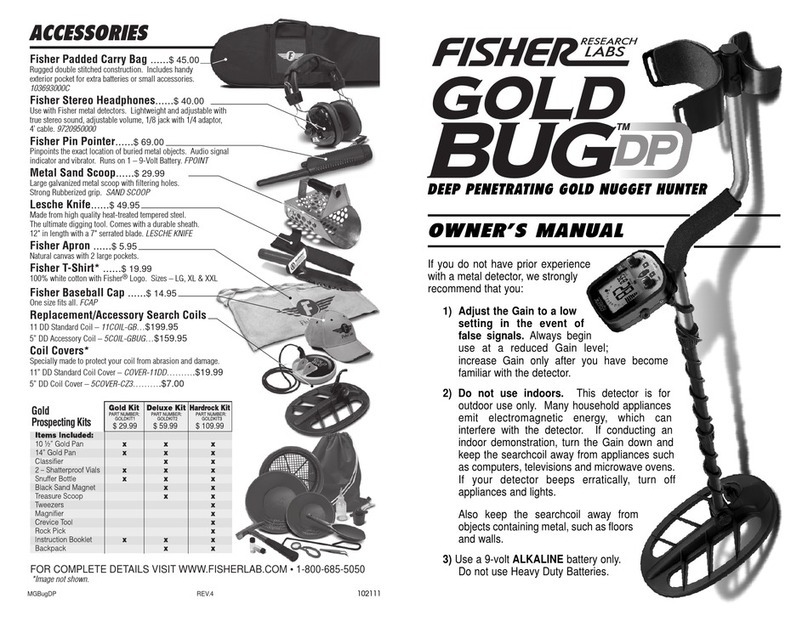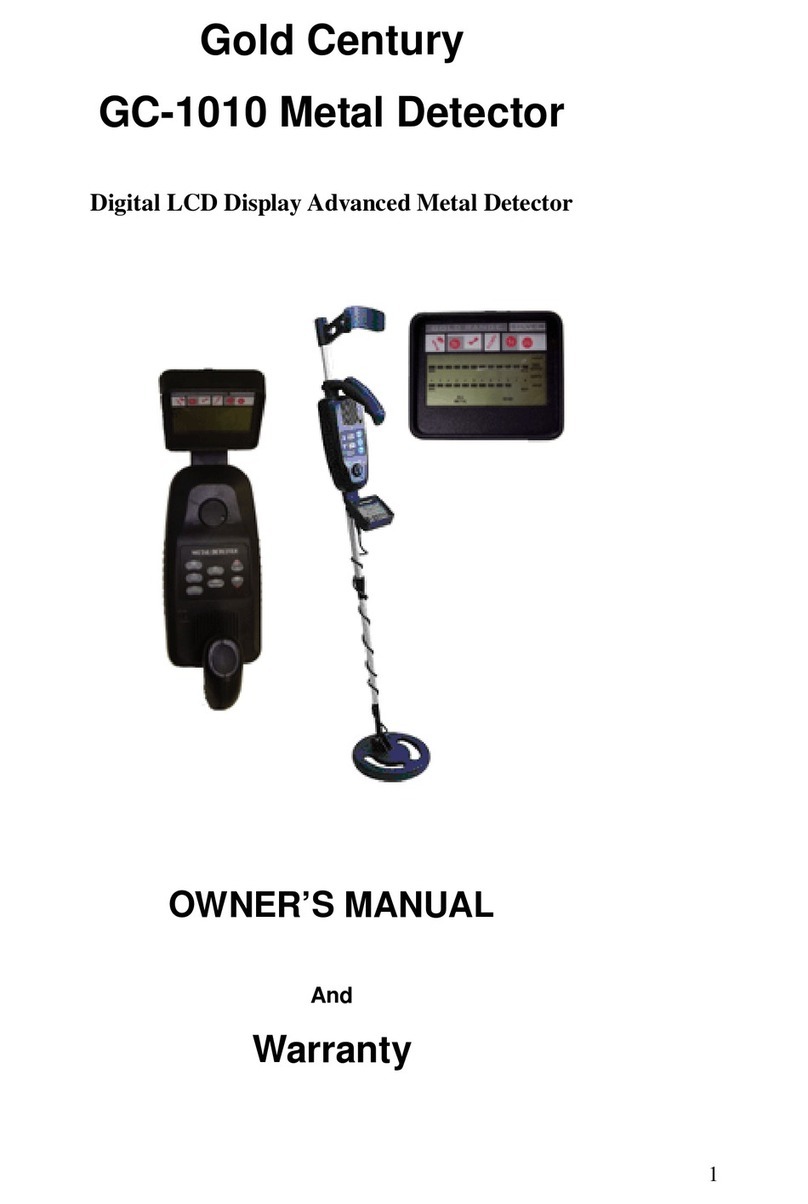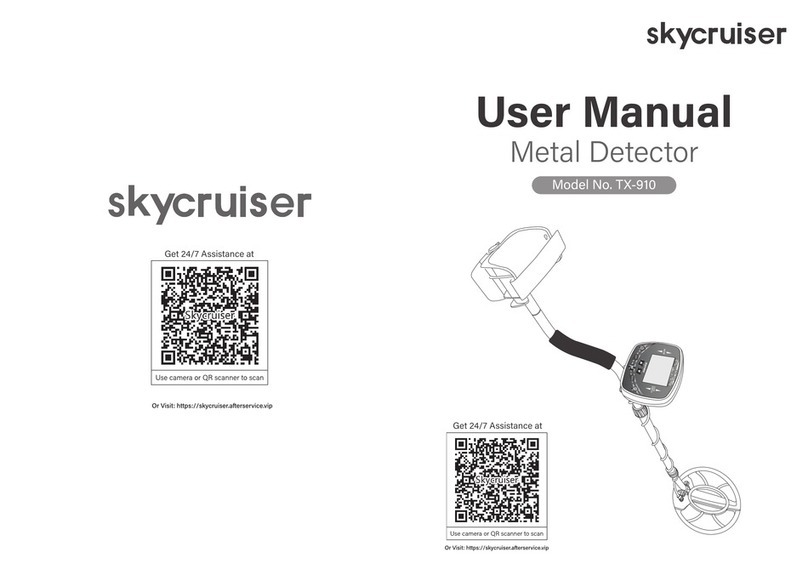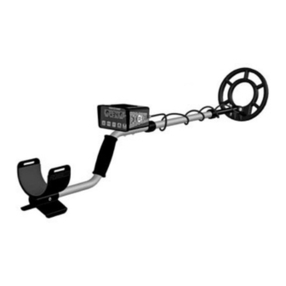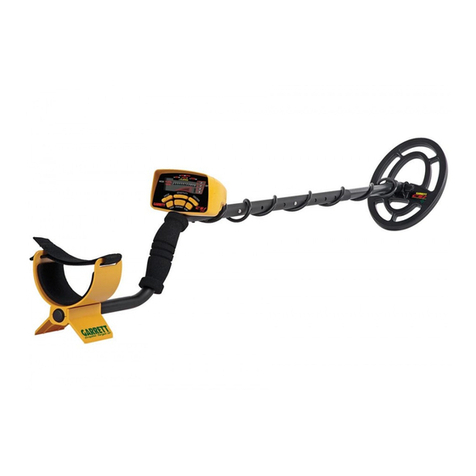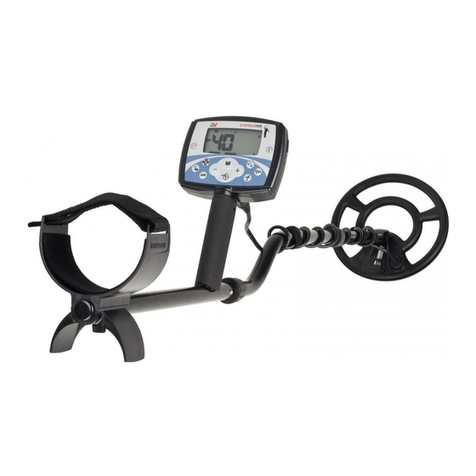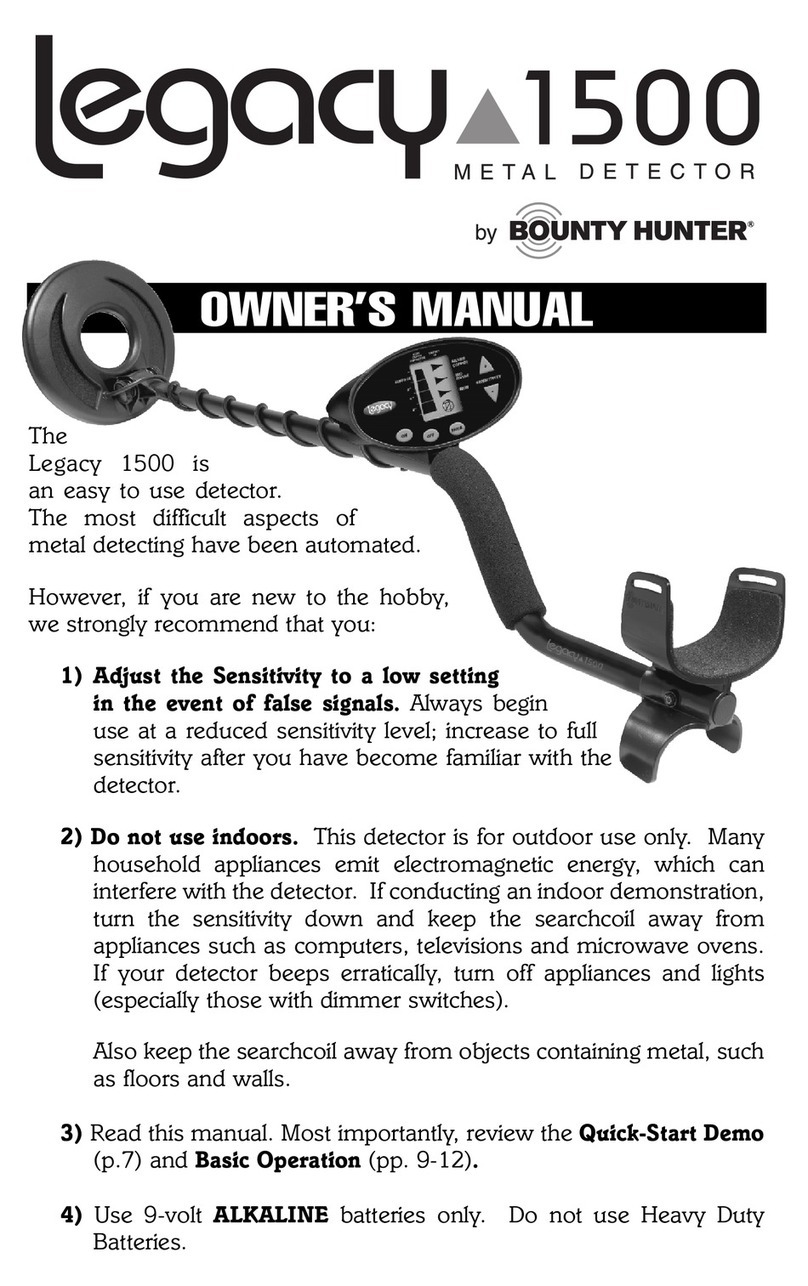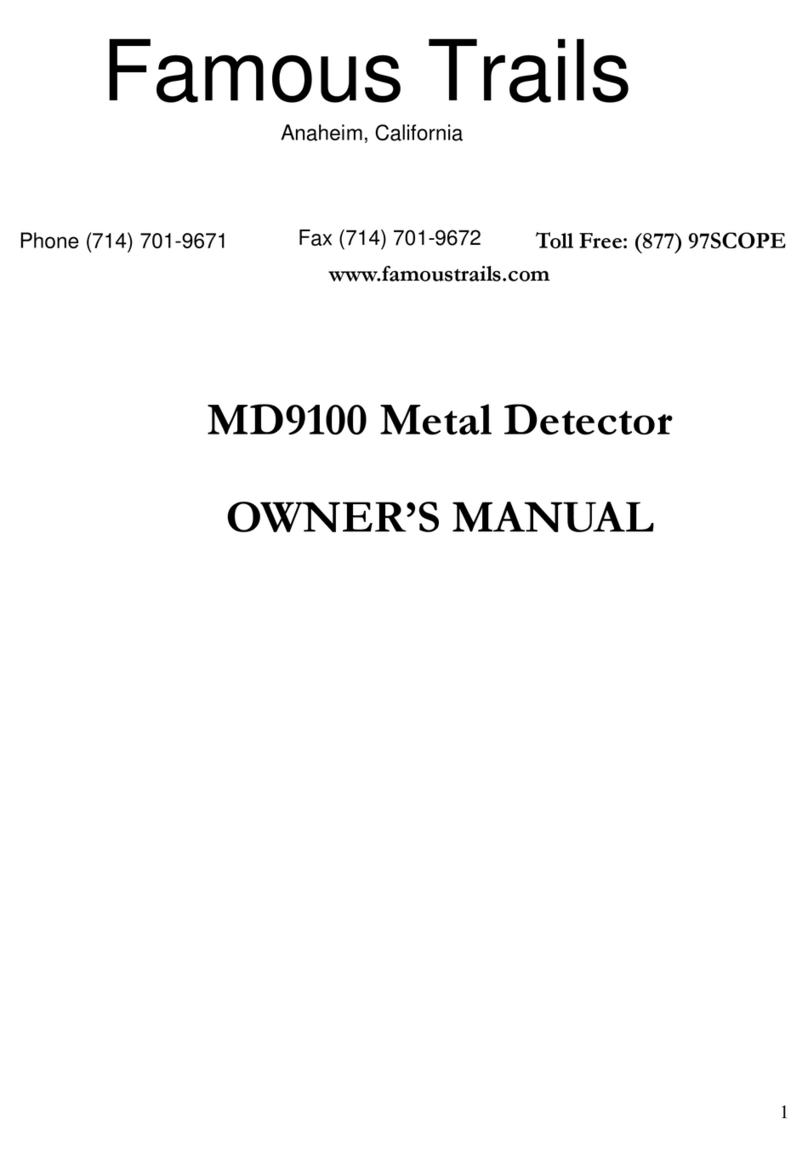Mylek MYMD1062 User manual

Metal Detector
MYMD1062
User Manual—Please read and retain for future reference
www.hsdonline.co.uk

Introduction:
General Information:
Please read the entire instruction manual before using the product
and then save it for future reference. We reserve the right for any
errors in text or images and any necessary changes made to technical
data. If you have any questions concerning technical problems please
contact our Customer Services on 0800 091 3171.
Contents:
1. Manual.
2. Metal Detector.
3. Shovel.
4. Earphones.
Features:
With your Metal Detector, you can hunt for coins, relics, jewelry, gold,
and silver just about anywhere. This metal detector is very versatile
and easy to use.
The detector’s features include:
Earphone Jack –lets you connect earphones to the detector for
privacy.
View Meter and Pointer –shows the probable type of metal being
detected.
Waterproof Search Coil –lets you use the detector’s search coil
even under water.
Note: The search coil is waterproof, but the control housing is not
waterproof.
Adjustable stem –lets you adjust the detector’s length for
comfortable use.
Note: Your metal detector requires six 1 x 9V DC battery (not
supplied)
www.hsdonline.co.uk

Technical Information:
Metal Detector
Model: MYMD1062
Voltage: 9V DC Battery
Sensitivity: 12 –15 cm
Parts List :
No. Description No. Description
1. PCB board 22 Handle
2. Screw 23 Screw
3. PCB board 24 Screw
4. Top Cover 25 Fixing knob
5. 26 Handle
6. Horn 27 Aluminium tube
7. Gauge 28 Battery label
8. Frame 29 Tube Sleeve
9. Screw 30 Sleeve
10. Potentiometer 31 Axis sleeve
11. Potentiometer 32 Base
12. Panel 33 Battery lid
13. PCB board 34 Aluminium tube
14. LED 35 Foam inlay
15. Switch 36 PCB board
16. Button 37 Knob
17. Winding 38 Knob
18. Socket for ear phone 39 Socket
19. PCB board 40 Plate cover
20. Knob 41 Plate
21. Winding
www.hsdonline.co.uk

www.hsdonline.co.uk

TREASURE HUNTER’S CODE OF ETHICS:
All treasure hunters might be judged by the example you set. Here are
a few basic rules you should follow while using your detector.
⚫Always get permission before searching any site.
⚫Respect the rights and property of others.
⚫Observe and respect all national and local laws while treasure
hunting.
⚫Never destroy historical or archaeological treasures. If you are not
sure about an object you have found, contact a museum or
historical society in your area.
⚫Leave the land and vegetation as it was. Fill in any holes you dig.
⚫Use your detector only in safe areas.
⚫Dispose of any junk you find, only in approved areas. Do not leave
it for the next treasure hunter to find.
Assembling the detector:
Assembling the detector is easy and requires no special tools. Just
follow these steps.
1. Unscrew the knobs on the search coil and remove. Insert the
smaller stem and align the holes on the search coil bracket and the
stem. Push the connector through the holes, then replace and
tighten the knobs.
2. Loosen the stem’s (connected with the handle) lock nut in the
direction of the arrow. Then insert the smaller stem into the big
stem connected with the handle. Turn the stem’s lock nut in the
reverse direction of the arrow to lock it in place.
www.hsdonline.co.uk

3. Insert the latch on the top of the handle into the assembly hole on
the bottom of the control box. Then slightly pull the handle in the
direction of IN on the handle to fix the latch in place.
4. Tighten the fixing screw to secure, do not over tighten.
5. Insert the search coil cable plug into the five pin jack on the rear
bottom of the control box’s housing.
6. Lengthen or shorten the stem, so when you stand upright with the
detector in your hand, the search coil is level with and about 1/2 to
2 inches above the ground.
Caution:
•The search coil cable plug fits into the connector only one way.
Do not force the plug.
•You do not need to disassemble the centre stem lock nut. In
case you accidently disassemble the centre stem lock nut place
the washer on the top of the stem connected with the handle
with the small head of the washer upwards. Then hitch the stem
lock nut on the washer then tighten to lock into place.
www.hsdonline.co.uk

ADJUSTING THE STEM:
Follow these steps to adjust the metal detector’s stem.
1. Carefully turn the stem’s lock nut clockwise until it loosens.
2. Lengthen or shorten the stem so when you stand upright you are
comfortable with the detector in your hand, the search coil is level
with and about 1/2 to 2 inches above the ground with your arm
relaxed at your side.
3. Carefully turn the stem’s lock nut counter clockwise to lock it in
place.
ADJUSTING THE SEARCH COIL:
Loosen the knobs at the search coil’s end and then adjust the search
coil to the desired angle. (The search coil should be parallel with the
ground.) Tighten the knobs just enough to keep the search coil from
rotating or wobbling.
www.hsdonline.co.uk

INSTALLING BATTERIES:
1. If the detector is on, turn VOLUME (on the control housing) to
OFF.
2. Press on the correct battery compartment cover and slide the
cover off in the direction of the arrow. Please note this unit only
requires 1 x 9v battery (not supplied) in the compartment
shown. The other battery compartment is fixed shut and should
not be forced open.
This compartment is fixed,
DO NOT force open.
Correct battery department.
3. Insert 1 x 9V battery into the compartment shown above.
4. Replace the cover. Your unit is now ready for use.
Caution:
⚫Use only fresh batteries of the required size and recommended
type.
⚫Do not mix old and new batteries, different types of batteries
(standard, alkaline, or rechargeable), or rechargeable batteries of
different capacities.
⚫If the detector is not to be used or to be stored remove the
batteries to avoid leakage.
USING EARPHONES:
You can connect a pair of earphones (supplied) to the detector so you
can listen to it privately. Using earphones also saves battery power
and makes it easier to identify subtle changes in the sounds you hear,
for better detection results.
Listening Safely:
To protect your hearing, follow these guidelines when you use
earphones.
•Set the volume to the lowest setting before plugging in the
earphones. Carefully adjust the volume to a comfortable level.
•Do not listen at extremely high volume levels.
•Once you set the volume, do not increase it. Over time, your
ears adapt to the volume level. High Volume levels can cause
discomfort and damage your hearing.
www.hsdonline.co.uk

To connect earphones to the detector, insert the earphones’ 1/8-inch
plug into the EAR jack on the bottom right on the front of the control
housing.
Note: The detector’s internal speaker disconnects when you connect
earphones.
Traffic Safety:
Do not wear earphones while operating your detector near high-traffic
areas. Even though some earphones are designed to let you hear
some outside sounds when listening at normal volume levels, they
still can present a traffic hazard.
OPERATION:
Your Metal Detector distinguishes between ferrous and nonferrous
metals. Ferrous metals contain iron, while non-ferrous metals such as
gold, silver, copper, platinum, aluminium, lead, and zinc do not.
When the detector senses a metallic object, the meter reading
changes and the detector might sound a tone. The actual reaction
depends on what metal is detected.
PREPARING THE DETECTOR:
Turning On the Detector
Hold the detector in a comfortable position and then rotate VOLUME
away from OFF to the desired sound level.
www.hsdonline.co.uk

Tuning the Detector:
1. Rotate VOLUME to the 11 o’clock position.
2. Set DISCRIMINATION to its midpoint.
3. Hold the search coil about 1 foot above the ground and keep away
from any metal objects.
4. Hold down the Auto Tune button on the handle until the pointer on
the view meter rests at or near 0, then release the Auto Tune
button.
5. Note: Press the Auto Tune button on the handle at any time during
operation to automatically return the pointer to 0.
TESTING AND USING THE DETECTOR:
To learn how the detector reacts to different metals, you should test it
before you use it the first time. You can test the detector indoors or
outdoors.
Indoor Testing
1. Remove any watches, rings, or other metal jewelry you are
wearing, then place the detector on a wooden or plastic table.
2. Adjust the search coil’s angle so the flat part faces the ceiling.
Note: Never test the detector on a floor inside a building. Most
buildings have metal of some kind in the floor, which might interfere
with the objects you are testing or mask the signal completely. Test
with the coil in correct direction as shown below.
3. Rotate VOLUME to the 11 o’clock position.
4. Set DISCRIMINATION to its midpoint.
5. Hold down the Auto Tune button until the pointer on the view
meter rests at or near 0, then release the Auto Tune button.
6. Move a sample of the material you want the detector to find (such
as a gold ring or a coin) about 2 inches above the search coil.
Notes:
The search coil will not detect without motion. You must move the
object since you are not sweeping with the detector at this time.
If you are using a coin, the detector detects it more easily if you hold
it so a flat side is parallel with the flat side of the search coil (not the
edge).
www.hsdonline.co.uk

If the detector detects the material, it might sound a tone. The pointer
moves to the left and the TARGET indicator indicates by red light
(ferrous) or to the right and the TARGET indicator indicates by green
light (non-ferrous) while the detector determines the type of metal it
is detecting. Usually the closer the detector gets to the metal object,
the bigger movement the pointer will make.
If the detector does not detect the material, check the battery power
and verify that the battery is properly connected. Also, you may need
to tune the detector (see “Tuning the Detector”).
Outdoor Testing and Use:
1. Find an area on the ground outside where there is no metal.
2. Place a sample of the material you want the detector to find (such
as a gold ring or a coin) on the ground. (If you are using valuable
metals such as gold to test the detector, mark the area where you
placed the item, to help you find it later. Do not place it in tall grass
or weeds).
3. Rotate VOLUME about two-thirds clockwise. Set
DISCRIMINATION to its midpoint.
4. Press and release the Auto Tune button on the handle until the
pointer is at or near 0. Then release the Auto Tune button. You
should barely hear a tone.
5.While holding the search coil level and about 1-2 inches above the
ground slowly move the search coil over the area where you placed
the sample, sweeping the search coil in a side-to-side in a arc line of
10-15cms motion like below.
www.hsdonline.co.uk

Search Coil Sweeping Hints:
⚫Never sweep the search coil as if it were a pendulum. Raising the
search coil while sweeping or at the end of a sweep causes false
readings. See below for correct sweep technique.
⚫Sweep slowly –hurrying makes you miss targets.
⚫When the detector detects a ferrous metal, sound becomes lower or
even disappears. Meanwhile the meter pointer moves to left. When
the detector finds a non-ferrous metal, it makes a louder sound and
the meter points to the right.
If the detector does not detect the material, check the battery power
and verify that the battery is properly connected. Also, you may need
to tune the detector (see “Tuning the Detector”).
Notes:
•The detector responds with a strong signal on the meter
when it detects most valuable metal objects. If a signal does
not repeat after you sweep the search coil over the target a
few times, the target is probably junk metal.
•False signals can be caused by trashy ground, electrical
interference, or large irregular pieces of junk metal.
•Try finding other metal in the area. When you find a metal
item, wait a few seconds, to allow the detector time to reset
(or, press the Auto Tune button on the handle to return the
pointer to the center of the view meter).
www.hsdonline.co.uk

Fine-tuning the detector:
After you become familiar with how your detector works, you can
fine-tune it to make it more selective in what it finds. Discrimination is
the detector’s ability to differentiate between types of metal. The
detector’s DISCRIMINATION setting determines whether the detector
will distinguish between different types of ferrous and non-ferrous
metals.
You can set DISCRIMINATION to minimum (fully counter clockwise),
to maximum (fully clockwise), or anywhere in between. As you set
DISCRIMINATION to higher levels, the detector may at first detect
iron objects, Aluminium, thick foil and finally metal objects like pieces
of silver paper. The pointer moves to the left and the TARGET
indicator indicates by a red light.
Metal objects set by DISCRIMINATION to be detected and the pointer
moves to the right and the TARGET indicator indicates by a green light
Note: Each time you use the detector in a different area, or
DISCRIMINATION is adjusted, you will need to re-tune the detector.
FALSE SIGNALS:
Because your detector is extremely sensitive, areas with high metal
content and other sources of interference might cause signals that
seem confusing. The key to handling these types of signals is to dig for
only those targets that generate a strong repeatable signal. As you
sweep the search coil back and forth over the ground, learn to
recognise the difference between signals that occur at random and
signals that are stable and repeatable. To reduce false signals when
searching scan only a small area at a time using slow, short
overlapping sweeps.
Detection hints:
No detector is 100 percent accurate. Various conditions influence
metal detection. The detector’s reaction depends on a number of
things:
The angle at which the object rests in the ground
The depth of the object
The amount of iron in the object
The size of the object
www.hsdonline.co.uk

PINPOINTING A TARGET
Accurately pinpointing a target makes finding the item easier.
Accurate pinpointing takes practice so we suggest you practice finding
and digging up small metal objects on your own property before you
search other locations. Sometimes, targets are difficult to accurately
locate due to the sweep direction. Try changing your sweep direction
to pinpoint a target.
Follow these steps to pinpoint a target.
1. When the detector detects a buried target, continue sweeping the
search coil over the target in narrowing side-to-side sweeping
motion. Make a visual note of the exact spot on the ground where
the detector beeps.
2. Stop the search coil directly over this spot on the ground. Then
move the search coil straight forward away from you and straight
back towards you a couple of times. Make a visual note of the exact
spot on the ground where the detector beeps.
3. Repeat Steps 1-2 at a right angle to the original search line,
making an “X” pattern. The target should be directly below the “X”
at the point of the loudest response.
Note:
⚫In areas where you get false signals, slow your sweep speed and use
shorter sweeps.
⚫Recently buried coins might not respond the same as coins buried for
a long period of time because of oxidation.
⚫Some nails, nuts, bolts, and other iron objects (such as old bottle
caps) oxidize and create a “halo” effect. A halo effect is caused by a
mixture of natural elements in the ground and the oxidation created
by different metals. Because of the metal mixtures, target signals
might not be in a “fixed” position. This effect makes these objects very
hard to detect accurately.
www.hsdonline.co.uk

TROUBLESHOOTING:
Problem
Suggestions
The detector
displays false
signals.
You might be sweeping the
detector’s search coil too fast or
at the wrong angle. Sweep the
search coil more slowly and hold
the detector correctly. See
“Testing and Using the Detector”
and “Pinpointing a Target”.
The detector might show a false
signal if it detects heavily
oxidized metals. Try pinpointing
the target from several different
angles (See “pinpointing a
Target”). If the detector does not
display the same signal each
time, the target is probably
heavily oxidized metal.
The display does
not show the
correct metal
type when the
detector finds a
target.
There might be more than one
target in the area you are
searching.
The target might be a type of
metal that the detector does not
recognize.
If the target is heavily oxidized,
the detector might not display
the correct metal type. This is not
a malfunction.
The detector
makes a
constant tone,
then goes silent
when it finds
metal
This is a normal function of the
detector.
www.hsdonline.co.uk

Environmental Responsibilities
Meaning of crossed –out wheeled dustbin:
Do not dispose of electrical appliances as unsorted municipal waste,
use separate collection facilities.
Contact your local council for information regarding the collection
systems available.
If electrical appliances are disposed of in landfills or dumps,
hazardous substances can leak into the groundwater and get into the
food chain damaging your health and well-being.
When replacing old appliances with new ones, the retailer is legally
obligated to take back your old appliance for disposal free of charge.
SERVICE WARRANTY
Hygiene Supplies Direct guarantees the product free from defects in
materials and workmanship for a period of 1 year from date of
purchase.
Should this unit be operated under conditions other than those
recommended, at voltages other than the voltage indicated on the
unit, or any attempts made to service or modify the unit, then the
warranty will be rendered void. The product you buy may sometimes
differ slightly from illustrations. This warranty is in addition to, and
does not affect, your statutory rights. If you have any problems with
this product, please call our Help Desk on 0800 091 3171 or email
Hygiene Supplies Direct Ltd, Castleford, England WF10 1PR declares that the Metal Detector is
exclusively manufactured and imported for Mylek.
Table of contents
Other Mylek Metal Detector manuals
